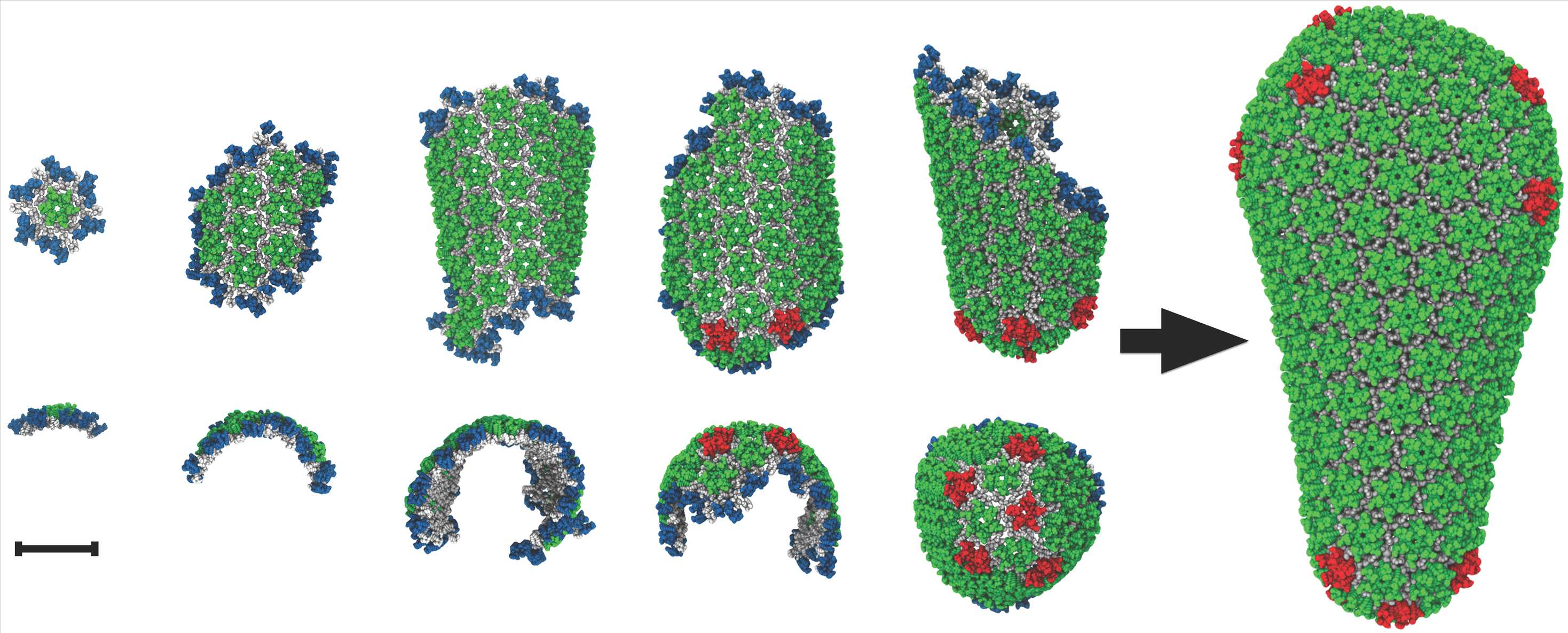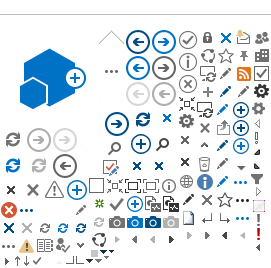
Active
View Entry | Assembly of the HIV capsid5729| The HIV capsid is a pear-shaped structure that is made of proteins the virus needs to mature and become infective. The capsid is inside the virus and delivers the virus' genetic information into a human cell. To better understand how the HIV capsid does this feat, scientists have used computer programs to simulate its assembly. This image shows a series of snapshots of the steps that grow the HIV capsid. A model of a complete capsid is shown on the far right of the image for comparison; the green, blue and red colors indicate different configurations of the capsid protein that make up the capsid “shell.” The bar in the left corner represents a length of 20 nanometers, which is less than a tenth the size of the smallest bacterium. Computer models like this also may be used to reconstruct the assembly of the capsids of other important viruses, such as Ebola or the Zika virus. The studies reporting this research were published in Nature Communications and Nature.
To learn more about how researchers used computer simulations to track the assembly of the HIV capsid, see this press release from the University of Chicago. | | Public Note | | | | | Internal Note | | John Grime [jgrime@uchicago.edu]
Actions
To:
Spiering, Martin (NIH/NIGMS) [C]
Cc:
Gregory A. Voth [gavoth@uchicago.edu]
Attachments:
(2)Download all attachments
ForNIGMS_TransparentBackgr~1.pdf (5 MB)[Open as Web Page]; ForNSF_TransparentBackground.pdf (5 MB)[Open as Web Page]
Inbox
Friday, June 17, 2016 1:19 PM
Wonderful!
I’ve attached two high-res images of the same form as the one on the website you linked. I saved one with an explicitly transparent background, in case that may be more convenient for your uses.
Please note: there are two citations involved here (Nature Communications 2016, and Nature 2011)! The full citations are given in the release form I emailed to you previously. We would greatly appreciate your care in ensuring both citations are included!
Cheers,
J.
On Jun 17, 2016, at 11:58 AM, Spiering, Martin (NIH/NIGMS) [C] wrote:
Hello John,
I've been told the release form represents no conflict, so the illustration can also be posted on the NIGMS image gallery. We'll also make an internal note that NSF has the same use privileges.
Thanks!
Martin
From: John Grime [jgrime@uchicago.edu]
Sent: Friday, June 17, 2016 12:24 PM
To: Spiering, Martin (NIH/NIGMS) [C]
Cc: Gregory A. Voth
Subject: Re: HIV capsid illustration for NIGMS image gallery?
Hi Martin,
I’ve attached the relase form we sent to the NSF for your perusal.
J.
> On Jun 17, 2016, at 11:10 AM, Spiering, Martin (NIH/NIGMS) [C] wrote:
>
> Hello John,
>
> Yes, a modified version would be excellent. Otherwise, I'll also need to ask the publisher for permission to use the image. Unlike some other publishers, NPG is usually pretty generous with granting permissions, but it can be a little time consuming and that they waive any fees is not guaranteed.
>
> However, I don't want to take up too much of your time. So if modifying the graphic entails quite a bit of work, please send me what you have, and I'll ask for permission from the journal via RightsLink.
>
> Many thanks,
> Martin
> ________________________________________
> From: John Grime [jgrime@uchicago.edu]
> Sent: Friday, June 17, 2016 12:01 PM
> To: Spiering, Martin (NIH/NIGMS) [C]
> Cc: Gregory A. Voth
> Subject: Re: HIV capsid illustration for NIGMS image gallery?
Hi Martin,
We provided the image shown in the news release to the NSF, which included signing a release form. Can I assume that giving you a high-res version of that image will not cause any problems in terms of copyright etc?
We’d rather not have the headache of upsetting anyint at either the NSF or the NIH over such matters!
I can of course provide a high-res version of that file, albeit somewhat modified so it is in principle unique to NIGMS?
J.
From: Gregory A. Voth [gavoth@uchicago.edu]
Sent: Friday, June 17, 2016 11:40 AM
To: Spiering, Martin (NIH/NIGMS) [C]
Cc: John Grime
Subject: Re: HIV capsid illustration for NIGMS image gallery?
Dear Martin,
Yes, of course. John Grime, cc’ed here, will provide you with the image. It is a composite of images from two articles that will need to be acknowledged and cited.
Best wishes,
Greg Voth
Gregory A. Voth, Ph.D.
Haig P. Papazian Distinguished Service Professor
Department of Chemistry, James Franck Institute, Institute for Biophysical Dynamics, and Computation Institute
Faculty Guest Researcher, Los Alamos National Laboratory
Department of Chemistry
The University of Chicago
5735 S. Ellis Avenue
Chicago, Illinois 60637
Phone: 773-702-9092
Fax: 773-795-9106
Administrative Assistant: 773-702-9096
Email: gavoth@uchicago.edu
Group Web Site: vothgroup.uchicago.edu
___________________________________________________________________
From: "Spiering, Martin (NIH/NIGMS) [C]"
Date: Friday, June 17, 2016 at 10:35 AM
To: Greg Voth
Subject: HIV capsid illustration for NIGMS image gallery?
Dear Dr. Voth,
I am a writer and editor with the Office of Communication and Public Liaison at the National Institute of General Medical Sciences. I'm reaching out to you because we noticed your striking illustration of the HIV capsid assembly in a recent news release (at https://news.uchicago.edu/article/2016/06/14/simulations-describe-hivs-diabolical-delivery-device) highlighting your groundbreaking work. We're interested in including your illustration into our image gallery (athttps://images.nigms.nih.gov/) to bring your work to broader public attention.
Images and videos in the NIGMS image gallery highlight NIGMS-funded work and are made available to the public for educational uses, provided that users credit the creator, i.e., you, for this work. Would you let us feature your work in this way? If so, could you send me a high-resolution and, if possible, unpublished version of the image?
Please let me know if you have any questions or concerns. I look forward to hearing from you.
Thank you,
Martin J Spiering, PhD, ELS
Writer & Editor (contractor)
OCPL, National Institutes of Health/NIGMS | | | Keywords | | capsid
HIV
AIDS
virus | | | Source | | John Grime and Gregory Voth, The University of Chicago | | | Date | | | | | Credit Line | | John Grime and Gregory Voth, The University of Chicago | | | Investigator | | Gregory Voth, The University of Chicago | | | Record Type | | Illustration | | | Topic Area(s) | | ;#Cells;#Genes;#Molecular Structures;#Tools and Techniques;# | | | Previous Uses | | NSF also has permission for use:
For Official NSF Use Only
Thank you for submitting your multimedia material (such as still image, photo, illustration, animation, video and/or audio) for use by the National Science Foundation (NSF). This form serves to verify that you own the copyright and hereby grant NSF permission to use your material in the manner described below. In view of your rights under U.S. Copyright laws, please check one of the following options, sign below and email to your contact at NSF:
NSF and External Use
By checking this option and signing below, you certify that you hereby grant NSF permission to use and distribute your multimedia material described below on a royalty-free basis for news and public-information purposes at NSF’s discretion. Such uses include, but are not limited to, posting the material on the NSF Multimedia Gallery Web site (thereby making it generally available to such outlets as news organizations, universities, teachers and the general public) and distributing the material to other Web sites for educational and/or informational purposes. NSF agrees to post in the Multimedia Gallery any restrictions stated on this form.
NSF News or Public-Information Use Only
By checking this option and signing below, you certify that you hereby grant NSF permission to use your multimedia material only in conjunction with distribution of official agency news or public-information products (including press releases and speeches by NSF officers) about NSF-supported research and education, and for no other purposes.
I,
John Grime
of
The University of Chicago
Full Name
Name of Organization
hold the copyright on this material and understand and agree to the terms of this form where I have indicated.
Signature
JOHN GRIME
Date
06/16/2016
(Your digital/typed signature on this line substitutes your hand-written signature.)
Address
Email
jgrime@uchicago.edu
Phone
(+1) 872 220 1232
Information about the Multimedia Material
NSF asks you to provide as much information as possible about each of your multimedia files, including descriptions, suggested credit and date. Please provide the highest available resolution of each item. If there are any restrictions on the use of the material, please specify these clearly.
File Name(s)
Please list all file names.
ForNSF.pdf
ForNSF_TransparentBackground.pdf
Brief Description
For each multimedia item, please include a brief non-technical description, which will be used for writing captions. Use a separate page for additional space.
These snapshots from a computer simulation shows steps in the assembly of the HIV-1 capsid, a pear-shaped capsule made of proteins that the virus needs in order to mature and become infective. The scale bar represents 20 nanometers, which is less than a tenth the size of the smallest bacterium. A model of a complete capsid suggested previously is shown on the far right of the image for comparison. (Citations: Nature Communications, doi: 10.1038/ncomms11568 and Nature 469:424-427 2011)
Keywords
Include any relevant keywords. Use a separate page for additional space.
Computer simulation, HIV, virus, capsid, molecular dynamics
Suggested Credit
Write how you would prefer to identify the copyright holder.
(Examples: “John Smith, Best University” or “John Smith, Biology Department, Best University”)
J. M. A. Grime and G. A. Voth, The University of Chicago
IMPORTANT: ENSURE THE FOLLOWING MANUSCRIPTS ARE BOTH CITED AS APPROPRIATE:
Grime and co-workers, Nature Communications, doi: 10.1038/ncomms11568
Pornillos and co-workers, Nature 469:424-427 2011
Related URL(s)
http://www.nature.com/ncomms/2016/160513/ncomms11568/full/ncomms11568.html
Does This Material Show NSF-Supported Research? Yes No
If yes, please explain and, if possible, provide the NSF grant number.
NSF awards OCI-0725070 and ACI-1238993 (Blue Waters supercomputing resource at the NCSA), and “Ultra-Coarse-Grained Simulations of Biomolecular Processes at the Petascale” Petascale Computing Resource Allocation (PRAC) support by the National Science Foundation (OCI-1440027).
Grant # OCI-0725070, ACI-1238993, OCI-1440027
Date Of Material
Please narrow down the creation date as closely as possible, even if you can give only the decade.
June 15th 2016
Restrictions for Use
Please note, if there is a restriction to use this multimedia material, NSF will gladly include the information on the NSF Web site. However, since the NSF Web site is open to the public and NSF does not monitor use of the material, NSF cannot guarantee that people using the site will adhere to restrictions posted. | | | Status | | Active | |
| | View All Properties | | Edit Properties |
|
